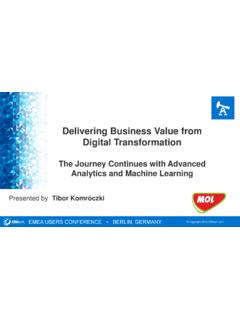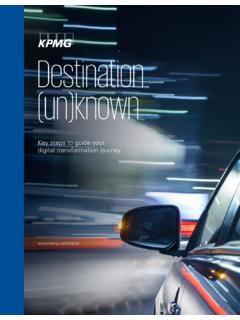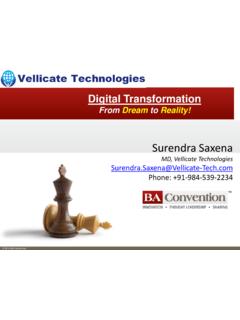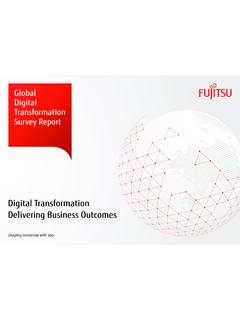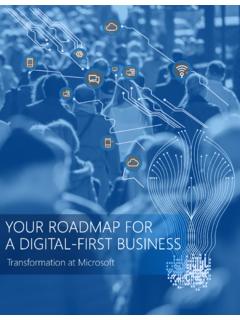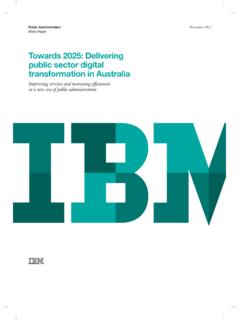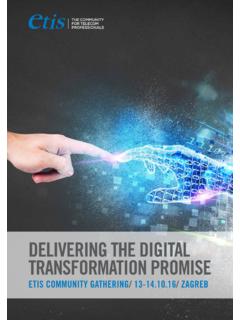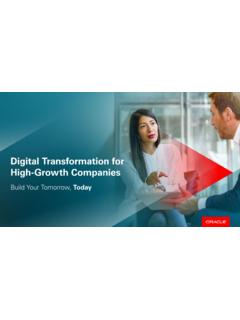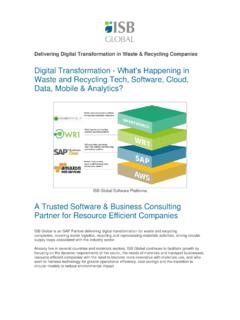Transcription of The journey to government’s digital transformation
1 The journey to government s digital transformationA Deloitte digital global surveyDeloitte digital is a digital consulting agency that brings together the creative and technologycapabilities, business acumen, and industry insight needed to help transform our clients businesses. Learn more at D. EggersWilliam Eggers, a leading authority on digital government , is responsible for research and thought leadership for Deloitte s Public Sector industry practice. He is the author of eight books, including his newest, co-authored with Paul Macmillan, The Solution Revolution: How business , government , and Social Enterprises are Teaming up to Solve Society s Biggest Problems (Harvard business Press, September 2013).
2 The book, which The Wall Street Journal calls pulsating with new ideas about civic and business and philanthropic engagement, was on many ten best books of the year lists. His books have won numerous awards including the 2014 Axiom book award for best book on busi-ness theory, the Louis Brownlow award for best book on public management, the Sir Antony Fisher award for best book promoting an understanding of the free economy, and the Roe Award for lead-ership and innovation in public policy research. He coined the term government in a book of the same name. He can be reached at or on Twitter Joel Bellman Joel Bellman is a partner with Deloitte in the United Kingdom, and Deloitte s global lead for digital transformation in the public sector.
3 He has worked extensively with central and local government organizations in the United Kingdom and elsewhere, leading programs that include building digital solutions, designing digital operating models, and delivering complex policy goals with innovative service designs. He is a regular author of blogs and publications covering digital and service trans-formation, including The ascent of digital : Understanding and accelerating the public sector s evolution, Making digital default: Understanding citizen attitudes, A mobile enabled government , Red ink rising: Navigating the perils of public debt, and Choosing fewer channels: Public service delivery options in an age of austerity.
4 He can be reached at or on Twitter the authorsA Deloitte digital global surveyContentsIntroduction | 1 Characteristics of a digitally maturing government | 4 Barriers and challenges to digital transformation | 12 Accelerating digital transformationKey questions public leaders need to consider | 22 Conclusion | 29 Appendix | 30 Endnotes | 35 The journey to government s digital transformationIntroductionIN the coming decade, several factors an aging population, the rise of Millennials, budget shortfalls, and ballooning entitlement spending could reshape the way govern-ment delivers services.
5 But the introduction of new digital technologies is likely to be the most important factor of all. Indeed, govern-ments from Toronto to Seoul are in the midst of a historic (and frequently wrenching) transformation as they abandon analog oper-ating models in favor of digital transforming government through the power of digital technologies will be a journey . We surveyed more than 1,200 gov-ernment officials from over 70 countries on digital transformation and interviewed another 140 government lead-ers and outside experts.* Overwhelmingly, they reported that digital technologies are having a major impact on government : Three-fourths of the respondents told us that digital technolo-gies are disrupting the public sector; nearly all (96 percent) characterized the impact on their domain as significant (figure 1).
6 Another key finding of the global survey that stands out is that governments are at very different stages in this journey . While a small percentage are what we consider matur-ing, the overwhelming majority are still in the early or developing stages of the digital - transformation jour-ney (sidebar). In fact, when asked about their organization s digital capabilities, only about 30 percent assessed their digital capabili-ties as ahead of their public sector peers; nearly 70 percent said they lagged behind the private sector (figure 4).Graphic: Deloitte University Press | extentModerate extentSmall extentNot at allDon t knowTo what extent do you perceive digital technologies are disrupting the public sector?
7 76%18%35%23%16%8%37%37%39%20%2%How much has your domain area been impacted by digital trends?2%96%Figure 1. Impact of digitalTruly transforming government through the power of digital technologies will be a journey .*More than half of the survey questions were sourced from the 2015 MIT Sloan Management Review and Deloitte digital business study. For more details, please refer to the Deloitte digital global survey1 digital MATURITY MODEL EXPLAINEDD igital maturity refers to the extent to which digital technologies have transformed an organization s processes, talent engagement, and citizen service models. We estimated the level of maturity based on responses to survey questions that broadly fell under three categories people, processes, and preparedness (figure 2).
8 Graphic: Deloitte University Press | 2. Maturity frameworkPEOPLED igital know-how; ability of leadership; workforce skills; avenues to upskill; enabling talentPROCESSESI nnovation and collaboration; citizen service; citizen involvement; open source usage; enabling procurementPREPAREDNESSS trategy articulation; investment reaction and response to digital trends; capability benchmarkingDIGITAL MATURITYB ased on our digital maturity estimation framework (described in the appendix), we classified respondent organizations into three categories: early, developing, and maturing (figure 3). The distribution of digital maturity among government agencies remains more or less similar across geographical We have been careful to refer to governments as digitally maturing rather than digitally mature because we are still at the early stages of the journey to digital transformation and no governments have yet to reach the end : Deloitte University Press | 3.
9 Global digital maturity distributionGraphic: Deloitte University Press | t knowFar behindBehindAbout the sameAheadFar aheadOther public sector organizations (n=1204)Private sector organizations (n=957)2%5%25%38%27%3%4%25%44%20%6%1%Fig ure 4. How do you think your organization s digital capabilities compare to:The journey to government s digital transformation2 Moreover, respondents reported low overall satisfaction with their organization s cur-rent reaction to digital trends and confidence in its readiness to respond to digital trends (figure 5). Even in the countries with the highest percentage of satisfied respondents New Zealand, Ireland, and Belgium only about half the respondents said their orga-nization s response to digital trends could be considered satisfactory.
10 Another interesting finding concerns what s actually driving digital transformation in government . Cost and budget pressures and citizen demands are far and away the two primary drivers, accounting for 75 percent of responses, whereas government direc-tives drive only 14 percent of agencies. These results, however, differ vastly across countries. At one end is the United Kingdom, where cost and budget pressures drive 56 percent of public sector organizations; at the other end is Canada, where 64 percent of government bod-ies cite citizen demands as the primary driver of digital the sections that follow, we explore findings related to the characteristics of public sector organizations at the forefront of using digital technologies to transform the way they function.










